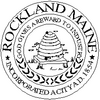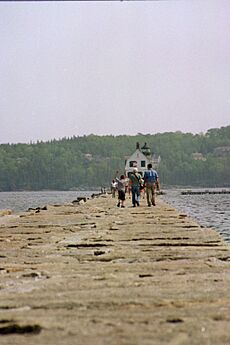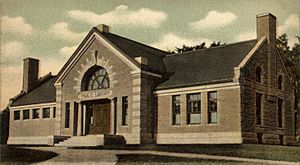Rockland, Maine facts for kids
Quick facts for kids
Rockland
|
||
|---|---|---|
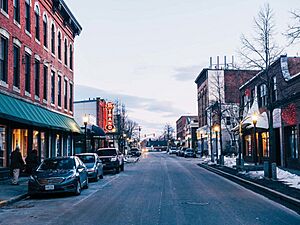
Rockland Downtown
|
||
|
||
| Nickname(s):
Vacationland
|
||
| Motto(s):
God Gives a Reward to Industry
|
||
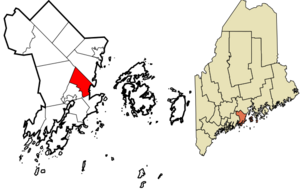
Location in Knox County and the state of Maine.
|
||
| Country | United States | |
| State | Maine | |
| County | Knox | |
| Incorporated (town) | July 28, 1848 | |
| Incorporated (city) | 1854 | |
| Area | ||
| • Total | 15.08 sq mi (39.05 km2) | |
| • Land | 12.85 sq mi (33.28 km2) | |
| • Water | 2.23 sq mi (5.77 km2) | |
| Elevation | 23 ft (7 m) | |
| Population
(2020)
|
||
| • Total | 6,936 | |
| • Density | 539.81/sq mi (208.42/km2) | |
| Time zone | UTC−5 (Eastern (EST)) | |
| • Summer (DST) | UTC−4 (EDT) | |
| ZIP code |
04841
|
|
| Area code(s) | 207 | |
| FIPS code | 23-63590 | |
| GNIS feature ID | 0574358 | |
Rockland is a city in Knox County, Maine, United States. It is the main city of the county. In 2020, about 6,936 people lived there.
Rockland is a popular place for tourists to visit. It is also where you can catch a ferry to islands in Penobscot Bay, like Vinalhaven, North Haven, and Matinicus.
Contents
History of Rockland
Long ago, the Abenaki Native American people called this area Catawamteak. This name meant "great landing place."
In 1767, John Lermond and his two brothers came from Warren. They built a camp to make wooden barrels and cut down pine trees for lumber. This area became known as Lermond's Cove. The first settlers arrived around 1769.
In 1777, the nearby town of Thomaston was officially formed. Lermond's Cove became a part of it, called Shore Village. On July 28, 1848, Shore Village became its own town, named East Thomaston. In 1850, its name was changed to Rockland. It officially became a city in 1854.
Rockland grew quickly because of two main industries: shipbuilding and making lime. In 1854 alone, the city built many ships. These included eleven large ships, three barks, six brigs, and four schooners.
The city had many lime quarries (places where stone is dug out). It also had 125 lime kilns, which are ovens used to turn limestone into lime. Over 300 ships were used to carry lime to different ports across the country.
In March 1877, a group called the Granite Cutters' International Union was started in Rockland. This was one of the first worker unions in the United States. It was formed by workers in the growing granite industry.
By 1886, the lime business was bigger than shipbuilding. There were twelve companies making lime, and they employed 1,000 workers. Still, Rockland had several shipyards, places to repair ships, and boatbuilders. Other businesses included grain mills, foundries (places for casting metal), carriage factories, lumber mills, machine shops, and cooperies (places that make barrels). There were also tanneries (for making leather), granite and marble works, boot and shoe factories, and printing offices. Fishing was also very important. Many Friendship Sloops (a type of fishing boat) sailed from the harbor to fishing spots in Penobscot Bay.
The Knox and Lincoln Railroad opened in 1871, bringing more tourists to Rockland. Hotels were built for them. The most famous was The Bay Point Hotel, built in 1889. It had a great view near the breakwater and offered many luxuries. It was renamed The Samoset Hotel in 1902. The hotel did well until the Great Depression in the 1930s. After that, fewer people visited. In the age of cars, people could travel anywhere, not just where trains went. The old Victorian hotel closed in 1969 and burned down in 1972. A new Samoset Resort opened in 1974.
In 1915, a new large warship called the USS Nevada (BB-36) did its tests and trials near Rockland's shore.
Today, Rockland is known as a micropolitan area, which means it's a small city that is a center for a larger area. Since the early 1990s, Rockland's economy has changed. It moved away from fishing and became more of a service center. Tourism has grown a lot. The downtown area now has unique shops, nice restaurants, and art galleries.
Rockland is the main business center for the midcoast Maine region. It has many historic inns, a coffee roaster, a food co-op, a community radio station WRFR-LP, the Farnsworth Art Museum, and the Center for Maine Contemporary Art (CMCA). In March 2008, Rockland was named a Coast Guard City. This shows the special connection the city has with the United States Coast Guard. In 2017, the Rockland City Council also voted to support community diversity.
Geography of Rockland
Rockland covers about 15.07 square miles (39.05 square kilometers). Most of this area is land, and a smaller part is water. Rockland is located on Penobscot Bay and the Gulf of Maine, which are part of the Atlantic Ocean. About ten miles to the east are the islands of North Haven and Vinalhaven. You can reach these islands by ferry from Rockland.
Major roads that pass through Rockland include U.S. 1 and 1A, and state routes 17, 73, and 90. Rockland shares borders with Owls Head to the southeast, Thomaston to the southwest, Warren to the northwest, and Rockport to the northeast.
Climate in Rockland
The coldest month in Rockland is January, and the warmest month is July.
| Climate data for Rockland, Maine | |||||||||||||
|---|---|---|---|---|---|---|---|---|---|---|---|---|---|
| Month | Jan | Feb | Mar | Apr | May | Jun | Jul | Aug | Sep | Oct | Nov | Dec | Year |
| Record high °F (°C) | 58 (14) |
61 (16) |
74 (23) |
80 (27) |
95 (35) |
94 (34) |
96 (36) |
93 (34) |
90 (32) |
82 (28) |
74 (23) |
63 (17) |
96 (36) |
| Mean daily maximum °F (°C) | 30 (−1) |
33 (1) |
40 (4) |
52 (11) |
62 (17) |
71 (22) |
76 (24) |
76 (24) |
68 (20) |
57 (14) |
47 (8) |
36 (2) |
54 (12) |
| Daily mean °F (°C) | 20 (−7) |
24 (−4) |
31 (−1) |
43 (6) |
53 (12) |
62 (17) |
68 (20) |
67 (19) |
59 (15) |
48 (9) |
39 (4) |
27 (−3) |
45 (7) |
| Mean daily minimum °F (°C) | 10 (−12) |
14 (−10) |
22 (−6) |
33 (1) |
43 (6) |
53 (12) |
59 (15) |
58 (14) |
50 (10) |
39 (4) |
30 (−1) |
18 (−8) |
36 (2) |
| Record low °F (°C) | −22 (−30) |
−20 (−29) |
−11 (−24) |
10 (−12) |
21 (−6) |
30 (−1) |
43 (6) |
37 (3) |
28 (−2) |
19 (−7) |
4 (−16) |
−25 (−32) |
−25 (−32) |
| Average precipitation inches (mm) | 4.26 (108) |
4.00 (102) |
4.80 (122) |
5.02 (128) |
4.14 (105) |
4.06 (103) |
3.43 (87) |
3.28 (83) |
4.51 (115) |
5.14 (131) |
5.71 (145) |
4.99 (127) |
53.34 (1,356) |
| Source: weather.com | |||||||||||||
Population of Rockland
| Historical population | |||
|---|---|---|---|
| Census | Pop. | %± | |
| 1850 | 5,052 | — | |
| 1860 | 7,316 | 44.8% | |
| 1870 | 7,074 | −3.3% | |
| 1880 | 7,599 | 7.4% | |
| 1890 | 8,174 | 7.6% | |
| 1900 | 8,150 | −0.3% | |
| 1910 | 8,174 | 0.3% | |
| 1920 | 8,100 | −0.9% | |
| 1930 | 9,075 | 12.0% | |
| 1940 | 8,899 | −1.9% | |
| 1950 | 9,284 | 4.3% | |
| 1960 | 8,769 | −5.5% | |
| 1970 | 8,505 | −3.0% | |
| 1980 | 7,919 | −6.9% | |
| 1990 | 7,972 | 0.7% | |
| 2000 | 7,609 | −4.6% | |
| 2010 | 7,297 | −4.1% | |
| 2020 | 6,936 | −4.9% | |
| U.S. Decennial Census | |||
2010 Census Information
In 2010, the census showed that 7,297 people lived in Rockland. There were 3,423 households, which are groups of people living together. About 23% of these households had children under 18. About 40% of all households were made up of people living alone.
The average age of people in the city was about 43.5 years old. About 18% of residents were under 18, and about 20% were 65 or older.
Arts and Culture in Rockland
Fun Places to Visit
Rockland is famous for the Maine Lobster Festival. This is a big celebration held every year in the first week of August. Thousands of people come from all over to enjoy this five-day event that honors lobster, a main product of the town.
Rockland is also home to the Center for Maine Contemporary Art. This art museum was designed by a famous architect named Toshiko Mori. Another well-known place is the Farnsworth Art Museum. It has paintings by famous artists like Andrew Wyeth and other artists from New England.
Rockland's main street has many small shops and businesses. You can find coffee shops, bookstores, art supply stores, restaurants, and toy stores. Penobscot Bay, which is next to Rockland, is known around the world as one of the best places for recreational sailing. The city's breakwater, a long stone wall built in the 1800s, also brings many tourists.
Places to See
- Rockland Public Library
- Farnsworth Art Museum
- Center for Maine Contemporary Art
- Lincoln Street Center for Arts and Education
- Maine Lighthouse Museum
- Maine Eastern Railroad
- Maine Lobster Festival
- North Atlantic Blues Festival
- Rockland Breakwater Light
- Rockland Historical Society and Museum
- Maine Boats, Homes, and Harbors Show
- University College at Rockland
- The Coastal Children's Museum
Education in Rockland
Here are some of the schools and learning centers in Rockland:
- Oceanside High School-East
- The Watershed School
- The Apprenticeshop
- Coastal Senior College
- Mid-Coast School of Technology
- Penobscot School
- UMA Rockland Center (formerly University College at Rockland)
Transportation in Rockland
Getting Around
U.S. Route 1 goes through Rockland. Maine State Route 17 goes north from the town, and Maine State Route 73 goes to the peninsula south of town.
The Maine State Ferry Service runs three ferry routes from the Rockland Ferry Terminal. Ferries go to Vinalhaven and North Haven several times a day. Ferries to Matinicus leave less often.
Buses from Concord Coach Lines also stop at the ferry terminal. You can take these buses to cities like Boston, Portland, Brunswick, and Bangor.
Train Travel
Until 1958, Rockland was the last stop for Maine Central Railroad passenger trains coming from Portland. These trains connected to others going to Boston, New York City, and Canada. The train service ended in April 1959.
From 2003 to 2015, the Maine Eastern Railroad offered special train rides to Rockland during certain seasons. These connected with Amtrak's Downeaster train in Brunswick. In 2017, there were plans to extend some weekend Downeaster trips to Rockland during the summer months, starting in 2018.
Notable People from Rockland
Many interesting people have connections to Rockland. Here are a few:
- Adelbert Ames: A Civil War general and a former governor of Mississippi.
- Hiram George Berry: A Civil War general.
- Alton H. Blackington: A journalist and photographer who wrote about New England.
- William T. Cobb: A former governor of Maine.
- Samuel Collins, Jr.: A state senator and judge.
- Leo Connellan: A poet.
- Gertrude Elliott: An actress.
- Maxine Elliott: An actress.
- David F. Emery: A U.S. congressman.
- Henry Faller: The person who started Uncle Henry's (a well-known publication).
- Nathan A. Farwell: A U.S. senator.
- Samuel C. Fessenden: Served in the U.S. Congress and was a judge in Rockland.
- Todd Field: A filmmaker who has been nominated for an Academy Award.
- Obadiah Gardner: A U.S. senator.
- Bo Goldman: A playwright and Oscar-winning screenwriter.
- Edward Sturgis Ingraham: An educator and mountaineer.
- Isaac Smith Kalloch: A former mayor of San Francisco.
- Charles E. Littlefield: A U.S. congressman.
- Theodore E. Long: A former college president.
- Herbert Lord: A director of the U.S. Bureau of the Budget.
- Samizu Matsuki: An artist and educator.
- Edward Mazurek: A state senator.
- Edna St. Vincent Millay: A poet who won a Pulitzer Prize.
- Edward C. Moran Jr.: A U.S. Representative.
- Louise Nevelson: A famous artist who moved to Rockland as a child.
- Edward Lawry Norton: An electrical engineer who developed the Norton equivalent circuit.
- Walter Piston: A composer who won a Pulitzer Prize.
- Robert B. Rheault: A former commander of Special Forces in Vietnam.
- Alice Marion Shaw: A composer and pianist.
- Carrie Burpee Shaw: A composer and educator.
- Katrina Smith: A state legislator.
- Charles Wilbert Snow: An educator, poet, and former Governor of Connecticut.
- James Breckenridge Speed: A businessman and giver of gifts to charity.
- Davis Tillson: A Civil War general and businessman.
Images for kids
See also
 In Spanish: Rockland (Maine) para niños
In Spanish: Rockland (Maine) para niños


